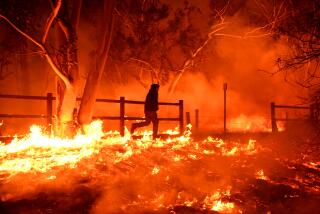Power Struggle: Crews Toil to Restore the Lights
- Share via
Bob Geivet was on his third consecutive 32/8 -- 32 hours on the job and eight hours off -- with no idea how many more he would work.
“Till it’s done,” the 58-year-old lineman said matter-of-factly as he worked on a one-mile stretch of Batavia Street in Orange that was still without power Friday morning, four days after the Southland was raked by gale force winds gusting to more than 100 mph.
Geivet was one of the battalions of Southern California Edison employees working on overdrive this week to repair the more than 300 power poles and 7,000 wires blown down or severely damaged between Sunday night and Tuesday morning. Service was sliced to more than 935,000 Southern California homes and businesses.
Edison called it the second-worst windstorm in the company’s 113-year history, behind only the windstorm of January 1997, which affected about a million of Edison’s 4.3 million residential and business customers.
Crews from as far as Ventura and Santa Barbara counties were dispatched to hard-hit areas in Orange County, the Inland Empire and the San Gabriel Valley. An additional 100 or so Pacific Gas and Electric workers drove from Northern California, and 101 contract crews were put into action.
By Friday morning, electricity had been restored to all but 540 homes and businesses in Orange, Riverside and San Bernardino counties. The bulk of these -- about 300 -- were concentrated in the city of Orange.
All were expected to be back on line Friday night or early today at the latest, Edison spokesman Steve Conroy said, thanks to the workers who climb utility poles to repair arcing lines and damaged transformers when even helicopters are grounded by high winds.
“They are the backbone of the company,” he said. “They’re the ones who keep the lights on.”
Edison workers know the drill when disaster hits -- long hours. Really long hours.
Especially on Batavia, where the wind blew a power pole onto the railroad tracks early Monday, then a commuter train smacked into it, dragging down 23 more poles, and severely damaging about two dozen others. Luckily, the poles fell into the street, causing little damage to buildings.
“With all the overtime, I figure I’ve really worked 45 years,” said Geivet, who joined the company 38 years ago. Still, he betrayed little fatigue under his close-cropped white beard and red baseball cap.
“I love it,” he said. “This is a challenge. It’s the adrenaline that keeps you going.”
It was a challenge indeed for those living or working near the outage area. Many businesses shut down. Others brought in generators.
At the Carrera home, candles lighted the bathrooms, the bedrooms, the living room and kitchen. An ice chest substituted for a refrigerator.
Without a food processor, Renee Carrera had to make salsa the way her mother did -- chopped in a stone bowl known as a molcajete instead of a food processor. It actually tasted better that way, she decided. After a few days, though, husband Enrique Carrera bought a gasoline-powered generator, putting an end to their primitive lifestyle.
Outside, Batavia was jammed by Edison trucks and heavy equipment. A backhoe was towed in. The street was closed to all but local traffic.
The 85-foot-high power poles had been replaced, planted 14 feet into the ground for stability. Workers in cherry pickers were stringing new high-voltage lines. A shaded area near the railroad tracks had been turned into a mess hall, where meals were served.
While the long hours can be taxing physically, they can be rewarding financially. As part of the International Brotherhood of Electrical Workers, union members receive time and a half after eight hours and double time for everything after 12 hours. Still, none of them mentioned the money.
The work had been intense, the linemen agreed. But Geivet recalled the 117 hours he worked without a break in 1994 when the lights went out in Monrovia.
“With a good crew, you can go forever,” he joked.
Scott Stueland told of the time in 1985 he worked 220 hours over two weeks.
“You’ve got to do what you’ve got to do,” said Charlie Stouff, a huge man who looks capable of shouldering a 3,000-pound utility pole himself.
Geivet and the team he heads in Santa Ana were on duty early Monday when the train yanked down the power poles. They could see the lights even though they were miles away.
“It was like fireworks,” said Bernard Cablayan. “I’ve never seen it flash so much.”
Days later, Cablayan struggled with fatigue. “When the sun comes up, it gives you a second wind,” he said. “But when it goes down, it’s a struggle.”
Sean Pettit said he’d been working almost nonstop for nearly a month. On Dec. 17, he and 80 others were dispatched to the Antelope Valley, where wind had blown down seven high-voltage towers. He worked 12 days of 16 hours on, eight hours off. At 6:30 a.m. Monday, he started the 32/8s, at first working in Santa Monica, moving to Eagle Rock, then to Orange.
There are limits to the amount of coffee you can drink, and too much food slows you down, Pettit said. Stueland told him the secret is to keep the tank a quarter full.
Pettit, 32, can’t remember what day it is. When this operation is over, he’ll sleep for a couple of days. Until then, he has a job to do. “There’s nobody else who can do it,” he said from behind dark sunglasses. “It just has to be done.”
More to Read
Sign up for Essential California
The most important California stories and recommendations in your inbox every morning.
You may occasionally receive promotional content from the Los Angeles Times.














